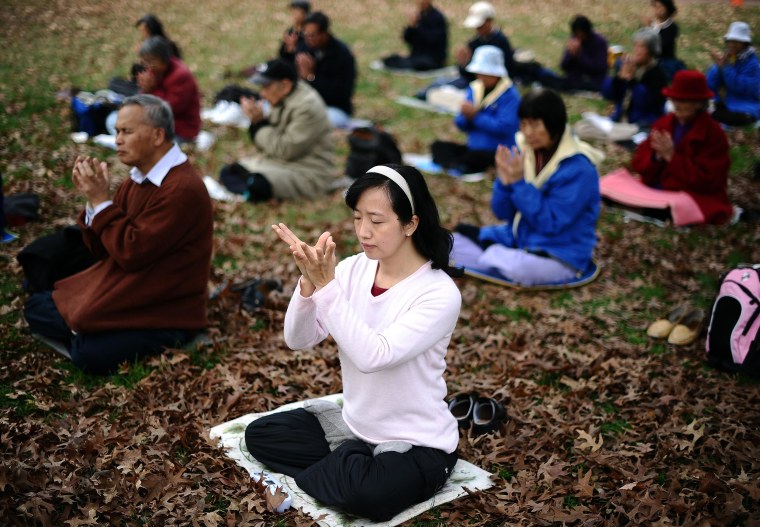
The power of meditation has been lauded by Wall Street titans and self-help gurus alike, and according to a recent national survey, more than 20 million Americans had practiced in the past 12 months. Yet, for the uninitiated, meditation can still seem like a mystery.
Here to provide five straightforward, practical tips on how to incorporate meditation into your daily life (even during boring meetings), is Dr. Richard J. Davidson, a professor of psychology and psychiatry at the University of Wisconsin-Madison and the founder of its Center for Investigating Healthy Minds. He is also the co-author of “The Emotional Life of Your Brain.”

Recent research using smart phones to collect data from large samples of individuals in the real world, asked people to respond to three essential questions:
- What are you doing right now?
- Where is your mind right now? Is it focused on what you are doing or is your mind elsewhere?
- How happy or unhappy are you right now?
They found that 47% of the time, individuals reported not paying attention to what they were doing in the moment. And when they were not attending to what they were doing, on average they were less happy than when they were attending to what they were doing. That is, being distracted exacts a cost on our well-being.
Being distracted exacts a cost on our well-being...if we become more mindful of our everyday activities, we can learn well-being and become happier.
We can do better and if we become more mindful of our everyday activities, we can learn well-being and become happier. One of the best strategies for doing so is through the regular practice of simple forms of meditation that can be taught in a completely secular way and that can train the mind to become more aware and to down-regulate negative emotions and increase the frequency of certain positive emotions.
Research in our laboratory has established that it does not take that much to make a difference. In a study that was published in 2013 on compassion meditation, we found that 30 minutes a day of practice over the course of two weeks was sufficient to produce a change in behavior and in brain function. Of course, we do not believe that such a change will endure unless a person continues to practice, much like with physical exercise where the impact of two weeks of daily training would quickly wear off if a person stopped exercising. The goal of these practices is to provide individuals with life-long methods that they can apply on a regular basis to maintain the gains they achieve.
What to do?
To begin a practice, here are some simple things you can do. Most important though is to do them in a relaxed way, not to push too hard or too long and to be sensitive to the effects they may have so that you can become your own teacher.
- The 5-minute Breath Awareness Practice: This is something that can be done anywhere, anytime. I recommend that you try it in the morning before the active period of your day begins, but at a time when you are awake. Sitting in an upright posture either in a chair with your feet comfortably touching the ground, or on a cushion or pillow on the floor with your legs crossed in a comfortable posture, notice your breathing. Simply become aware of your breathing. You can notice sensations around your nose or belly or elsewhere in your body. Do not get too focused on any one type of sensation but simply and gently become aware of your breathing. When you notice that your mind has wandered (and it will), gently bring your awareness back to your breathing. In addition to doing this practice in the morning before you start your day, you can do this anywhere. If you are in a boring meeting, you can become aware of your breathing. If you are walking between locations at work, you can do this. If you are waiting on line somewhere, this practice can be wonderful in cultivating more patience. No one needs to know you are meditating! You can simply be aware.
- Walking Practice: This is great way to both get physical and mental exercise. Often when we walk, we are distracted with thoughts about the past and the future and spend so little time focusing on the present: what is actually happening right now. If you have a regular walk that you do each day, either at work or to work or to something after work, take a part of it and devote it intentionally to becoming aware. Notice whatever sensations are associated with movement. Notice how the quality of your awareness is the same or different from when you are not moving. Notice the feelings in your legs and feet as you move. Awareness is the key to meditation and intentionally being aware of the present is at the core. Movement provides a wonderful support for your awareness.
- Body Scan During the Day: If you have a job during which you are mostly in one location sitting, or standing for part of the time, taking a few minutes to simply become aware of your body can be very helpful. Don’t try to manipulate your body but rather simply become aware of your body. Sometimes it can help to move your awareness through your body, beginning with your head, face and neck and then descending through each part of the body. Simply notice whatever sensations you might feel, whether they are pleasant, unpleasant or neutral. As with each of these practices, whenever you notice that your mind has wandered, simply bring it back to the present moment.
- Loving Kindness and Compassion Practice: After settling into your posture with an upright spine, reflect on the fact that just as you wish to be happy and to be free of suffering, so too do others have this same wish. Then bring to mind a loved one or someone you care about who might be having a difficult time, suffering in some way and as you visualize this person, cultivate the aspiration that they be relieved of their suffering. You can use two simple phrases that you can silently repeat to help you: “May you be happy and enjoy the causes of happiness”, “May you be free of suffering and the causes of suffering.” Notice whatever sensations arise as you do this.
- Loving Kindness and Compassion in Your Daily Life: If you find yourself in a situation where they are people (or animals) around you—it could be in a large office area, in an airport, in a grocery store, walking on a busy street, on a bus, in a train, in a plane, in a park, literally anywhere—as you notice the people or being around you, intentionally cultivate the wish that they be happy and free of suffering. You can use abbreviated phrases to help you with this: “May you be happy!”, “May you be free of suffering!”. Explore how doing this impacts your emotional state.
Support and Resources:
It is often very helpful when you first take up the practice of meditation to find a teacher who can help guide you and others who are learning to provide support and companionship on this journey. Nowadays, many parts of the U.S. have various programs to learn meditation in medical centers, at community centers, at retreat centers, in colleges and universities and many other venues. I would encourage you to seek out such opportunities because it is often the case that having this kind of support, particularly when one is first learning to practice, can be enormously beneficial. Although each of these practices on the face of it seems very easy, and they are, in certain ways they can also be quite difficult because our minds are unruly and most people find it hard to focus which leads to frustration.
You can find more resources, including a guided compassion meditation practice that you can download by going to the website of our Center for Investigating Healthy Minds at the University of Wisconsin-Madison:
www.investigatinghealthyminds.org/
For more information and inspiration visit MariaShriver.com
